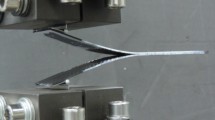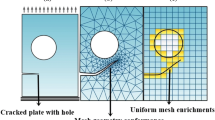Abstract
Prediction of delamination failure is challenging when the researchers try to achieve the task without overburdening the available computational resources. One of the most powerful computational models to predict the crack initiation and propagation is cohesive zone model (CZM), which has become prominent in the crack propagation studies. This paper proposes a novel CZM using high-dimensional model representation (HDMR) to capture the steady-state energy release rate (ERR) of a double-cantilever beam (DCB) under mode I loading. The finite element models are created using HDMR-based load and crack length response functions. Initially, the model is developed for 51-mm crack size DCB specimens, and the developed HDMR-based CZM is then used to predict the ERR variations of 76.2-mm crack size DCB model. Comparisons have been made between the available unidirectional composite (IM7/977-3) experimental data and the numerical results obtained from the 51-mm and 76.2-mm initial crack size DCB specimens. In order to demonstrate the efficiency of the proposed model, the results of the second-order nonlinear regression model using RSM are used for the comparison study. The results show that the proposed method is computationally efficient in capturing the delamination strength.
















Similar content being viewed by others
References
Herrmann H, Eik M, Berg V, Puttonen J (2014) Phenomenological and numerical modelling of short fibre reinforced cementitious composites. Meccanica 49:1985–2000
Johnson WS, Mangalgiri PD (1987) Investigation of fiber bridging in double cantilever beam specimens. J Compos Technol Res 9:10–13
Spearing SM, Evans AG (1992) The role of fiber bridging in the delamination resistance of fiber-reinforced composites. Acta Metall Mater 40:2191–2199
Anderson T, Anderson TL (2017) Fracture mechanics: fundamentals and applications. CRC Press, Boca Raton, FL
Sørensen BF, Jacobsen TK (1998) Large-scale bridging in composites: R-curves and bridging laws. Compos A Appl Sci Manuf 29:1443–1451
Shanmugam V, Penmetsa R, Tuegel E, Clay S (2013) Stochastic modeling of delamination growth in unidirectional composite DCB specimens using cohesive zone models. Compos Struct 102:38–60
Arora VK, Bhushan G, Aggarwal ML (2017) Enhancement of fatigue life of multi-leaf spring by parameter optimization using RSM. J Braz Soc Mech Sci Eng 39:1333–1349
Balu AS, Rao BN (2014) Efficient assessment of structural reliability in presence of random and fuzzy uncertainties. J Mech Des 136:051008
Balu AS, Rao BN (2012) High dimensional model representation-based formulations for fuzzy finite element analysis of structures. Finite Elem Anal Des 50:217–230
Rabitz H, Alis ÖF, Shorter J, Shim K (1999) Efficient input-output model representations. Comput Phys Commun 117:11–20
Li G, Rosenthal C, Rabitz H (2001) High dimensional model representations. J Phys Chem A 105(33):7765–7777
Bauer J, Kozubal J, Puła W, Wyjadłowski M (2012) Application of HDMR method to reliability assessment of a single pile subjected to lateral load. Studia Geotechnica et Mechanica 34(3):37–51
Balu AS, Rao BN (2011) Explicit fuzzy analysis of systems with imprecise properties. Int J Mech Mater Des 7:283–289
Naveen BO, Balu AS (2018) HDMR-based model update in structural damage identification. Int J Comput Methods 15(2):1840004–1840014
Ezzine MC, Amiri A, Tarfaoui M (2018) Experimental and numerical investigation of the fracture behavior of adhesive shear tests single lap joints. J Braz Soc Mech Sci Eng 40:382
Sane AU, Padole PM, Manjunatha CM, Uddanwadiker RV, Jhunjhunwala P (2018) Mixed mode cohesive zone modelling and analysis of adhesively bonded composite T-joint under pull-out load. J Braz Soc Mech Sci Eng 40:167
Panettieri E, Fanteria D, Firrincieli A (2015) Damage initialization techniques for non-sequential FE propagation analysis of delaminations in composite aerospace structures. Meccanica 50:2569–2585
Barenblatt GI (1959) The formation of equilibrium cracks during brittle fracture. General ideas and hypotheses. Axially-symmetric cracks. J Appl Math Mech 23:622–636
Liu G, Zhou D, Ma J, Han Z (2016) Numerical investigation of mixed-mode crack growth in ductile material using elastic–plastic XFEM. J Braz Soc Mech Sci Eng 38:1689–1699
Roesler J, Paulino GH, Park K, Gaedicke C (2007) Concrete fracture prediction using bilinear softening. Cem Concr Compos 29:300–312
Park K, Paulino GH, Roesler JR (2008) Determination of the kink point in the bilinear softening model for concrete. Eng Fract Mech 75:3806–3818
Park K, Paulino GH, Roesler J (2010) Cohesive fracture model for functionally graded fiber reinforced concrete. Cem Concr Res 40:956–965
Jin ZH, Paulino GH, Dodds RH (2003) Cohesive fracture modeling of elastic-plastic crack growth in functionally graded materials. Eng Fract Mech 70:1885–1912
Rao BN, Kuna M (2008) Interaction integrals for fracture analysis of functionally graded magnetoelectroelastic materials. Int J Fract 153:15–37
Gregory JR, Spearing SM (2004) A fiber bridging model for fatigue delamination in composite materials. Acta Mater 52:5493–5502
Feih S (2006) Development of a user element in ABAQUS for modelling of cohesive laws in composite structures. Riso National Laboratory, Roskilde
Rice J (1968) A path independent integral and the approximate analysis of strain concentration by notches and cracks. J Appl Mech 35:379–386
Suo Z, Bao G, Fan B (1992) Delamination R-curve phenomena due to damage. J Mech Phys Solids 40:1–16
Balu AS, Rao BN (2013) Confidence bounds on design variables using high-dimensional model representation–based inverse reliability analysis. J Struct Eng 139:985–996
Alış ÖF, Rabitz H (2001) Efficient implementation of high dimensional model representations. J Math Chem 29:127–142
Wang SW, Levy H, Li G, Rabitz H (1999) Fully equivalent operational models for atmospheric chemical kinetics within global chemistry-transport models. J Geophys Res 104:30417–30426
Author information
Authors and Affiliations
Corresponding author
Additional information
Technical Editor: Paulo de Tarso Rocha de Mendonça, Ph.D..
Publisher's Note
Springer Nature remains neutral with regard to jurisdictional claims in published maps and institutional affiliations.
Appendix: A
Appendix: A
1.1 Development of HDMR equations using five sample points (n = 5)
Consider the first-order HDMR expression to develop the response surface equations,
For N = 5 and n = 5: \(\tilde{f}\left( {\mathbf{x}} \right) = \sum\nolimits_{i = 1}^{5} {\sum\nolimits_{j = 1}^{5} {\upphi_{j} (x_{i} )f(c_{1} \ldots ,c_{i - 1} \ldots ,x_{i}^{j} \ldots ,c_{i + 1} \ldots ,c_{N} ) - (N - 1)f_{0} } }\)
The expanded form of the above expression is given as:
In order to obtain the HDMR expression for the desired response, the functions \(f(c_{1} \ldots ,c_{i - 1} \ldots ,x_{i}^{j} \ldots ,c_{i + 1} \ldots ,c_{N} )\) are evaluated using ABAQUS. Table 7 shows the component functions and corresponding load and crack length values. The responses (load and crack length) for the function evaluations in the above expansion are as below:
The number of function evaluations can be obtained by using Eq. (13).
The shape/interpolation function \(\phi_{j} \left( {x_{i} } \right)\) is evaluated using the Lagrange interpolation:
Considering the first expansion function, for i = 1 and j = 1–5, the expression of Expansion 1 for load (having 51 mm initial crack) is given by
Similarly, all the five HDMR functions are evaluated, and summation of all gives the HDMR approximation equation for load response \(\left( {Y_{1} } \right)\) as below:
Similarly, the HDMR approximation equations are developed for the crack length of 51 mm, load and crack length of 76.2 mm initial crack, i.e., \(Y_{2} ,Y_{3} {\text{ and }}Y_{4}\).
Rights and permissions
About this article
Cite this article
Kesava Rao, B., Balu, A.S. Modeling of delamination in fiber-reinforced composite using high-dimensional model representation-based cohesive zone model. J Braz. Soc. Mech. Sci. Eng. 41, 254 (2019). https://doi.org/10.1007/s40430-019-1761-4
Received:
Accepted:
Published:
DOI: https://doi.org/10.1007/s40430-019-1761-4




